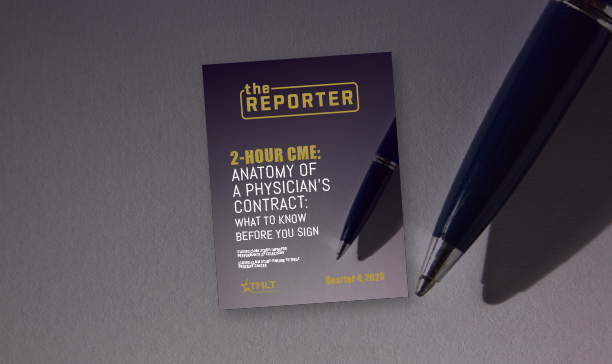Complications from spinal fusion procedure
A 50-year-old man came to see a pain management physician. He reported lower left side pain that radiated to the left hip with pressure on his lower back.
Presentation
A 50-year-old man came to see a pain management physician (PM Physician A) on March 1, 2022. The patient’s history included hypertension, knee replacement, and knee and back pain. He had a BMI of 47 (Class III or extreme obesity).
The patient reported lower left side pain that radiated to the left hip with pressure on his lower back. A week earlier, the patient had a caudal epidural steroid injection (CESI) at L4-L5 that failed to relieve his pain.
He also recently completed a prescribed program of chiropractic care for six weeks and had an MRI two months earlier.
The MRI findings revealed “congenital lumbar spinal stenosis with superimposed acquired central canal stenosis at L2/L3, L3/L4, and L4/L5 with cauda equina crowding and exiting nerve root anatomic impingement. There is a 3mm annular bulge at L2/L3 and again at L3/L4. Bilateral L5 nerve root anatomic impingement was found and moderate acquired central canal stenosis at L1/L2 with 3mm annular bulge and bilateral L1 nerve root anatomic impingement.”
Physician action
PM Physician A examined the patient and documented decreased sensation on the lower left thigh, knee, medial leg, lateral leg, and dorsum of the foot. Straight leg raising test was positive at degrees. The patient was noted as “ambulating independently with normal gait.”
The physician’s impression was lumbar spondylolistheses, degeneration of lumbar intervertebral disc, and spinal stenosis of the lumbar region. PM Physician A scheduled the patient for spinal fusion surgery on March 16. Fusion would be at the patient’s L4-L5, using a minimally invasive, interspinous-interlaminal fusion device to stabilize and create space in the spine.
On March 15, a pre-surgical x-ray of a lateral view of the patient’s lumbar spine did not show any evidence of acute fractures. Results of a new MRI showed severe, multi-level intervertebral disc disease at L1-L2 and L3-L4. Anterolisthesis was found at L4-L5.
The next day, PM Physician A took the patient to surgery at Hospital A. He obtained informed consent from the patient and documented the patient’s history and physical exam. He also noted that the patient’s previous epidural steroid injections indicated that the source of the pain originated from a nerve root compression and degeneration involving the L3-L4 segment.
PM Physician A used fluoroscopic guidance for the procedure. The L4-L5 segment was identified on lateral view as the spinous processes of the adjacent segments. During the procedure, PM Physician A attempted to place a guide pin between the spinous processes at the L4-L5 segment. However, the interspace was too tight, and the guide pin would not pass through to the contralateral side. The procedure was aborted.
The patient was discharged the next day on March 18, with prescriptions for acetaminophen 300mg for low back pain with no refills, cephalexin 500mg, and tizanidine 4mg.
The patient was rescheduled for posterolateral fusion and fixation at L4-L5 with allograft bone graft implants on March 23. The patient reported to Hospital A for surgery as scheduled and PM Physician A performed the procedure.
The operative note did not note patient positioning prior to the procedure, only indicating that it was appropriate. No complications were noted, and vitals remained stable. The physician also noted the patient was able to transfer himself to the OR stretcher on his own and was transported to the recovery room in stable condition.
While in the post-anesthesia care unit, the patient began having severe diarrhea. The nurses notified PM Physician A. He did not come to evaluate the patient, as he did not feel the diarrhea was related to the surgery. He recommended anti-diarrhea medication for the patient.
The patient was discharged, but his condition deteriorated when he arrived home. His daughter called EMS. When they arrived, they found the patient in respiratory distress with gastrointestinal bleeding. The patient was transported to Hospital B but was comatose on arrival and in hemorrhagic shock. The patient was admitted to the ICU, intubated, and given vasopressors and multiple transfusions.
Imaging revealed a small retroperitoneal hemorrhage. An esophagogastroduodenoscopy with embolization of the gastroduodenal artery was performed. The patient was in multi-organ system failure and his condition in steep decline. The patient died the next day.
Allegations
A lawsuit was filed against PM Physician A and Hospital A. The allegations included:
- failure to have the proper training, experience, and skill necessary to perform a complex spinal surgery;
- failure to properly position the patient during surgery;
- unnecessary and improper surgical technique;
- failure to address postop complications; and
- improper and unsafe postoperative discharge of patient.
Legal implications
Consultants for the plaintiff and defense criticized PM Physician A for acting outside the scope of his specialty (pain management) in performing complex spinal surgeries. The procedures in this case are typically performed by orthopedic spine surgeons or neurosurgeons. PM Physician A’s training in this procedure was from a four-day training session.
Hospital A was also alleged to be negligent for not verifying PM Physician A’s board certification and specialized training (fellowship or advanced certification) before allowing him to perform this surgery.
A defense neurosurgery expert stated that PM Physician A erroneously documented and coded the procedures as an L4-L5 fusion with fixation but there was no fixation. This expert believed that the surgery resulted in an L4 transverse process fracture and a retroperitoneal bleed. The expert further stated that PM Physician A violated the retroperitoneal space and this led to the patient’s death.
Both plaintiff and defense consultants stated that the patient was not safely positioned for spinal surgery in a way that would protect his abdominal organs and circulation. There was no documentation that the patient was adequately monitored, or that his position was adjusted to avoid compression of and damage to his organs, circulation, and tissues.
There was little to no documentation on the patient’s positioning. Members of the surgical team testified that padding was used to position the patient, but there was finger pointing among the team about who was responsible for monitoring the patient’s position and his post-surgical care.
There was also minimal documentation about the patient’s history or pre-operative condition. There was no documentation of the patient’s potential risks and contraindications. Extreme obesity and inability to lie prone for the duration of the procedure are established contraindications for these types of procedures. There was no documentation of whether risks and contraindications were discussed with the patient or his family before surgery. The results from the patient’s preoperative MRI were also not found in the patient record.
Disposition
The case was settled on behalf of PM Physician A. The hospital also settled with the plaintiff.
Risk management considerations
As the general U.S. population ages, the need for more intensive pain care is on the rise. To meet demand, many physicians in pain management and anesthesiology have expanded their skillsets to include interventional pain procedures and surgeries.
It is the position of the American Academy of Pain Medicine that “interventional pain procedures, and surgeries, be performed by a physician with sufficient training and expertise for the performance of any given procedure, as are the standards in other interventional and surgical subspecialties in medicine.” (1)
To learn more about the requirements for expanding clinical skills or performing new procedures, please check with your state medical board or specialty society.
In this case, PM Physician A’s documentation was either minimal or absent. Complete, accurate, and contemporaneous documentation is a physician’s first, best defense in the event of a claim. Poor or sloppy documentation may lead a jury, plaintiff’s attorney, or another physician to think the documenting health care professional is negligent or uncaring toward the patient. Thorough patient records help physicians maintain a better continuity of care between providers and reduce questions of liability in the event of a claim.
Source
- American Academy of Pain Medicine. AAPM Statement on Scope of Practice in Pain Medicine. Approved by the AAPM Executive Committee on September 6, 2017. Available at https://painmed.org/aapm-statement-on-scope-of-practice-in-pain-medicine/. Accessed July 28, 2025.
Disclaimer
Presentation
A 50-year-old man came to see a pain management physician (PM Physician A) on March 1, 2022. The patient’s history included hypertension, knee replacement, and knee and back pain. He had a BMI of 47 (Class III or extreme obesity).
The patient reported lower left side pain that radiated to the left hip with pressure on his lower back. A week earlier, the patient had a caudal epidural steroid injection (CESI) at L4-L5 that failed to relieve his pain.
He also recently completed a prescribed program of chiropractic care for six weeks and had an MRI two months earlier.
The MRI findings revealed “congenital lumbar spinal stenosis with superimposed acquired central canal stenosis at L2/L3, L3/L4, and L4/L5 with cauda equina crowding and exiting nerve root anatomic impingement. There is a 3mm annular bulge at L2/L3 and again at L3/L4. Bilateral L5 nerve root anatomic impingement was found and moderate acquired central canal stenosis at L1/L2 with 3mm annular bulge and bilateral L1 nerve root anatomic impingement.”
Physician action
PM Physician A examined the patient and documented decreased sensation on the lower left thigh, knee, medial leg, lateral leg, and dorsum of the foot. Straight leg raising test was positive at degrees. The patient was noted as “ambulating independently with normal gait.”
The physician’s impression was lumbar spondylolistheses, degeneration of lumbar intervertebral disc, and spinal stenosis of the lumbar region. PM Physician A scheduled the patient for spinal fusion surgery on March 16. Fusion would be at the patient’s L4-L5, using a minimally invasive, interspinous-interlaminal fusion device to stabilize and create space in the spine.
On March 15, a pre-surgical x-ray of a lateral view of the patient’s lumbar spine did not show any evidence of acute fractures. Results of a new MRI showed severe, multi-level intervertebral disc disease at L1-L2 and L3-L4. Anterolisthesis was found at L4-L5.
The next day, PM Physician A took the patient to surgery at Hospital A. He obtained informed consent from the patient and documented the patient’s history and physical exam. He also noted that the patient’s previous epidural steroid injections indicated that the source of the pain originated from a nerve root compression and degeneration involving the L3-L4 segment.
PM Physician A used fluoroscopic guidance for the procedure. The L4-L5 segment was identified on lateral view as the spinous processes of the adjacent segments. During the procedure, PM Physician A attempted to place a guide pin between the spinous processes at the L4-L5 segment. However, the interspace was too tight, and the guide pin would not pass through to the contralateral side. The procedure was aborted.
The patient was discharged the next day on March 18, with prescriptions for acetaminophen 300mg for low back pain with no refills, cephalexin 500mg, and tizanidine 4mg.
The patient was rescheduled for posterolateral fusion and fixation at L4-L5 with allograft bone graft implants on March 23. The patient reported to Hospital A for surgery as scheduled and PM Physician A performed the procedure.
The operative note did not note patient positioning prior to the procedure, only indicating that it was appropriate. No complications were noted, and vitals remained stable. The physician also noted the patient was able to transfer himself to the OR stretcher on his own and was transported to the recovery room in stable condition.
While in the post-anesthesia care unit, the patient began having severe diarrhea. The nurses notified PM Physician A. He did not come to evaluate the patient, as he did not feel the diarrhea was related to the surgery. He recommended anti-diarrhea medication for the patient.
The patient was discharged, but his condition deteriorated when he arrived home. His daughter called EMS. When they arrived, they found the patient in respiratory distress with gastrointestinal bleeding. The patient was transported to Hospital B but was comatose on arrival and in hemorrhagic shock. The patient was admitted to the ICU, intubated, and given vasopressors and multiple transfusions.
Imaging revealed a small retroperitoneal hemorrhage. An esophagogastroduodenoscopy with embolization of the gastroduodenal artery was performed. The patient was in multi-organ system failure and his condition in steep decline. The patient died the next day.
Allegations
A lawsuit was filed against PM Physician A and Hospital A. The allegations included:
- failure to have the proper training, experience, and skill necessary to perform a complex spinal surgery;
- failure to properly position the patient during surgery;
- unnecessary and improper surgical technique;
- failure to address postop complications; and
- improper and unsafe postoperative discharge of patient.
Legal implications
Consultants for the plaintiff and defense criticized PM Physician A for acting outside the scope of his specialty (pain management) in performing complex spinal surgeries. The procedures in this case are typically performed by orthopedic spine surgeons or neurosurgeons. PM Physician A’s training in this procedure was from a four-day training session.
Hospital A was also alleged to be negligent for not verifying PM Physician A’s board certification and specialized training (fellowship or advanced certification) before allowing him to perform this surgery.
A defense neurosurgery expert stated that PM Physician A erroneously documented and coded the procedures as an L4-L5 fusion with fixation but there was no fixation. This expert believed that the surgery resulted in an L4 transverse process fracture and a retroperitoneal bleed. The expert further stated that PM Physician A violated the retroperitoneal space and this led to the patient’s death.
Both plaintiff and defense consultants stated that the patient was not safely positioned for spinal surgery in a way that would protect his abdominal organs and circulation. There was no documentation that the patient was adequately monitored, or that his position was adjusted to avoid compression of and damage to his organs, circulation, and tissues.
There was little to no documentation on the patient’s positioning. Members of the surgical team testified that padding was used to position the patient, but there was finger pointing among the team about who was responsible for monitoring the patient’s position and his post-surgical care.
There was also minimal documentation about the patient’s history or pre-operative condition. There was no documentation of the patient’s potential risks and contraindications. Extreme obesity and inability to lie prone for the duration of the procedure are established contraindications for these types of procedures. There was no documentation of whether risks and contraindications were discussed with the patient or his family before surgery. The results from the patient’s preoperative MRI were also not found in the patient record.
Disposition
The case was settled on behalf of PM Physician A. The hospital also settled with the plaintiff.
Risk management considerations
As the general U.S. population ages, the need for more intensive pain care is on the rise. To meet demand, many physicians in pain management and anesthesiology have expanded their skillsets to include interventional pain procedures and surgeries.
It is the position of the American Academy of Pain Medicine that “interventional pain procedures, and surgeries, be performed by a physician with sufficient training and expertise for the performance of any given procedure, as are the standards in other interventional and surgical subspecialties in medicine.” (1)
To learn more about the requirements for expanding clinical skills or performing new procedures, please check with your state medical board or specialty society.
In this case, PM Physician A’s documentation was either minimal or absent. Complete, accurate, and contemporaneous documentation is a physician’s first, best defense in the event of a claim. Poor or sloppy documentation may lead a jury, plaintiff’s attorney, or another physician to think the documenting health care professional is negligent or uncaring toward the patient. Thorough patient records help physicians maintain a better continuity of care between providers and reduce questions of liability in the event of a claim.
Source
- American Academy of Pain Medicine. AAPM Statement on Scope of Practice in Pain Medicine. Approved by the AAPM Executive Committee on September 6, 2017. Available at https://painmed.org/aapm-statement-on-scope-of-practice-in-pain-medicine/. Accessed July 28, 2025.
Disclaimer
Want to save this article for later?
Download the full issue as a PDF for future reference or to share with colleagues.
Subscribe to Case Closed to receive insights from resolved cases.
You’ll receive two closed claim studies every month. These closed claim studies are provided to help physicians improve patient safety and reduce potential liability risks that may arise when treating patients.
Related Resources
Discover more insights, stories, and resources to keep you informed and inspired.






